Jean Bornoy, was an architect of the Countie of Hainaut ( part of it was conquest by Louis XIV) architect active in the 15th century in Brussels, in the surroundings of Philippe le Bon, duke of Burgundy.
He is probably the first and true designer of the Brussels Town Hall which currently forms its left wing.
His name appears in the book of expenses for the construction of the town hall for the year 1405, which specifies that "Master" Jean Bornoy worked with 17 masons, 4 stonemasons and 27 companions.
His main collaborator was Jacob van Thienen.
As for the tower, it is the work of Jan van Ruysbroeck

The Grand Place or Grote Markt is the central square of Brussels, Belgium. It is surrounded by opulent Baroque guildhalls of the former Guilds of Brussels and two larger edifices; the city's Flamboyant Town Hall, and the neo-Gothic King's House or Breadhouse building containing the Brussels City Museum. The square measures 68 by 110 metres.

Etterbeek is one of the 19 municipalities of the Brussels-Capital Region, Belgium. It neighbours the municipalities of Auderghem, the City of Brussels, Ixelles, Schaerbeek, Woluwe-Saint-Lambert and Woluwe-Saint-Pierre. In common with all of Brussels' municipalities, it is legally bilingual (French–Dutch).

Victor Pierre Horta was a Belgian architect and designer, and one of the founders of the Art Nouveau movement. His Hôtel Tassel in Brussels built in 1892–1893, is often considered the first Art Nouveau house, and, along with three of his other early houses, is listed as a UNESCO World Heritage Site. The curving stylized vegetal forms that Horta used influenced many others, including architect Hector Guimard, who used it in the first house he designed in Paris and in the entrances he designed for the Paris Metro. He is also considered a precursor of modern architecture for his open floor plans and his innovative use of iron, steel and glass.
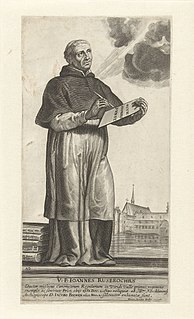
John van Ruysbroeck, original Flemish name Jan van Ruusbroec was an Augustinian canon and one of the most important of the Flemish mystics. Some of his main literary works include The Kingdom of the Divine Lovers, The Twelve Beguines, The Spiritual Espousals, A Mirror of Eternal Blessedness, The Little Book of Enlightenment, and The Sparkling Stone. Some of his letters also survive, as well as several short sayings. He wrote in the Dutch vernacular, the language of the common people of the Low Countries, rather than in Latin, the language of the Catholic Church liturgy and official texts, in order to reach a wider audience.

The Cathedral of St. Michael and St. Gudula is a medieval Roman Catholic church in central Brussels, Belgium. It is dedicated to St. Michael and St. Gudula, the patron saints of the City of Brussels, and is considered to be one of the finest examples of Brabantine Gothic architecture.

Jan van Ruysbroeck was a Flemish architect of the early 15th century. He served as official architect to the Duke of Brabant. His best known work was the tower of Brussels' Town Hall. The Gothic building, which stands in the city's Grand Place, is widely regarded as a masterpiece of medieval European secular architecture. It was designed by Jacob van Thienen some time around 1402 and van Ruysbroek's tower was added between 1444 and 1463.

Jacobvan Thienen was a Flemish architect of the early 15th century. He is believed to have designed the spectacular Brussels Town Hall circa 1402. This Gothic building, which stands in the city's Grand Place, is widely regarded as a masterpiece of medieval European secular architecture. The building's distinctive belfry was, however, the work of a different architect, Jan van Ruysbroeck.

Uccle or Ukkel is one of the 19 municipalities located in the Brussels-Capital Region of Belgium. In common with all of Brussels' municipalities, it is legally bilingual (French–Dutch).
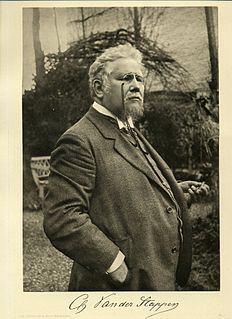
Charles van der Stappen, was a Belgian sculptor, born in Saint-Josse-ten-Noode.
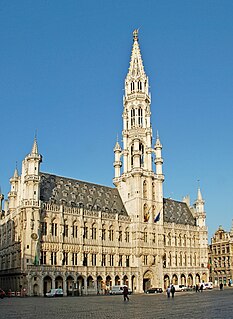
The Town Hall of the City of Brussels is a Gothic building from the Middle Ages. It is located on the famous Grand Place in Brussels, Belgium, opposite the Brussels City Museum. It is the only remaining medieval building of the Grand Place and is considered a masterpiece of civil Gothic architecture and more particularly of Brabantine Gothic.
John of Schoonhoven was a Flemish theologian and writer.
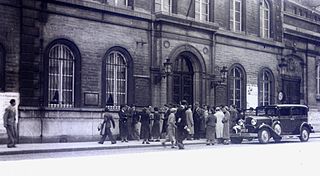
The Académie Royale des Beaux-Arts - École supérieure des Arts de la Ville de Bruxelles (ARBA-ESA), in Dutch Koninklijke Academie voor Schone Kunsten van Brussel, is the Belgian art school, established in Brussels in the Kingdom of Belgium. It was founded in 1711. At the beginning housed in a single room in the city hall, in 1876 the school moved to a former convent and orphanage in the Rue du Midi / Zuidstraat, rehabilitated by the architect Pierre-Victor Jamaer, where the school still operates.

The Royal Museum of the Armed Forces and Military History is a military museum that occupies the two northernmost halls of the historic complex in Cinquantenaire Park in Brussels, Belgium. The park is set on the continuation of Rue de la Loi/Wetstraat, which starts at the end of Brussels' Park before the Royal Palace.

Antoine-Félix Bouré, known in his own time as Félix Bouré but sometimes found in modern scholarship as Antoine Bouré, was a Belgian sculptor, best known for his monumental lions.

Sculpture in Brussels is sculpture that has been created in Brussels since the Middle Ages with the construction of Brussels' Hôtel de Ville and Claus Sluter's arrival in Brussels - he lived there from 1380 to 1385 before moving to Dijon.

Neoclassical architecture appeared in Belgium during the period of Austrian occupation in the mid-18th century and enjoyed considerable longevity in the country, surviving through periods of French and Dutch occupation, and the birth of Independent Belgium, surviving well into the 20th century.
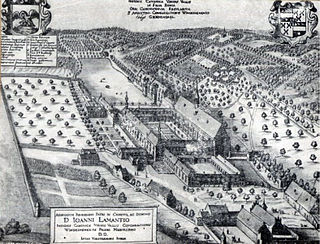
Groenendael Priory is located in the Forest of Soignes in the municipality of Hoeilaart in the Flemish Brabant, about 10 kilometres (6.2 mi) southeast of Brussels, Belgium.

Louis Samain was a Belgian sculptor. Samain was born in Nivelles, and studied at the Académie Royale des Beaux-Arts in Brussels under Louis Simonis. After winning the Belgian Prix de Rome, he lived for a time in Italy. In 1889, he was awarded a gold medal at the Paris Exposition Universelle, and in 1895 his work was shown at the Société des Artistes Français in Paris. He died in Ixelles.

The Collegiate Church of St. Peter and St. Guido is a Roman Catholic collegiate church located in the centre of Anderlecht, a municipality of Brussels (Belgium). It is dedicated to Saint Guy, the patron saint of the Anderlecht, and was built between the 14th and 16th centuries in Brabantine Gothic style. Its neo-Gothic spire dates from the 19th century.